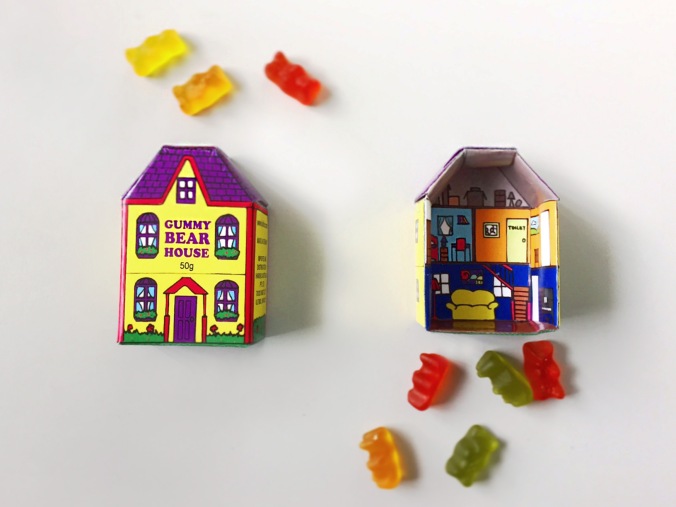Contextualise your own design practice in relation to some aspect of the theoretical content covered in the readings. Your response should compare your own work to that of another recognised designer’s.
Written by Anhkim Tran
Postmodernism is a way of analyzing and challenging social structures in society, which can be understood in relation to modernism. Postmodernism questions the ideas and values of modernism, and does not have a particular set belief or values since they reject conventional ideas of originality. 1 Therefore postmodernists favours the pastiche of “dead” styles, which is the “mimicry of other styles and particularly of the mannerisms and stylistic twitches of other styles”.2 My packaging design follows a similar approach in comparison with Michael Graves’s architecture design, which challenged modernism.
In relation to postmodernism, the design aesthetic of my gummy bear packaging rejects the ideals of modernism. In my design practice, I do not follow the rules established by modernism since I added ornamentation or broke the grid that is used by modernist designers. This is not to say I abandon modernism because I sometimes design with the mindset of going for a clean look. However I also embrace styles that are outside of modernism, similar to postmodernists who adopt old styles because they believe that there is no absolute truth and that old rules or styles can open up to different cultural manifestations. What is seen is “tasteful” or “tasteless” is created by society to maintain class and gender differences but postmodernism views that all taste can be equally valid.3 Therefore, stylistic features such as ornamentation, which is rejected in modernism can be applied in the works of a postmodernist, such as Michael Graves. My packaging favours decorative features and the house design itself reminds of a traditional looking house rather than a modern one. As a designer, I often look back at old styles as to bring a feeling of nostalgia to my design work. Postmodernist designers like Michael Graves challenge and critique the ideals of modernism.
Michael Graves was a postmodernist architect who started out in modernism but then focused on a more humanist approach from the 1970s. He used colours which gave warmth to urban landscapes and favoured classical structures. The photograph below depicts Graves’s design for Graves School of Architecture’s satellite campus in Wenzhou, China. In contrast to modernist design, there are a variety of different colours used to compliment the landscape and Graves liked to emphasize on ornament, aesthetics and colour in his work that remind viewers of the classical style.4 Likewise, I used a variety of colours to create a playful and eye catching aesthetic. Graves also included curved forms such as the cylinder and the arc for an organic look. The design has different sized windows, which add interest and variety. His design conveys how he favours the pastiche of “old” style, which is rejected by modernism but embraced by postmodernism as they critique and challenge established ideas and beliefs that are considered as “truth”.
Graves School of Architecture’s satellite campus in Wenzhou, China. Designed by Michael Graves
Gummy bear house packaging
1. Daniel Palmer, “Explainer: What is Postmodernism,” The Conversation, Accessed 5 April 2017, http://theconversation.com/explainer-what-is-postmodernism-20791.
2. Hal Foster, The Anti-aesthetic: Essays on Postmodern Culture, (Port Townsend, Wash. : Bay Press, 1983), 133.
3. Penny Sparke, An Introduction to Design and Culture: 1900 to the Present, 2nd ed. (London: Routledge, 2004), 190-191.
4. “Michael Graves Biography,” Biography, Accessed 5 April 2017, http://www.biography.com/people/michael-graves-9318661.
